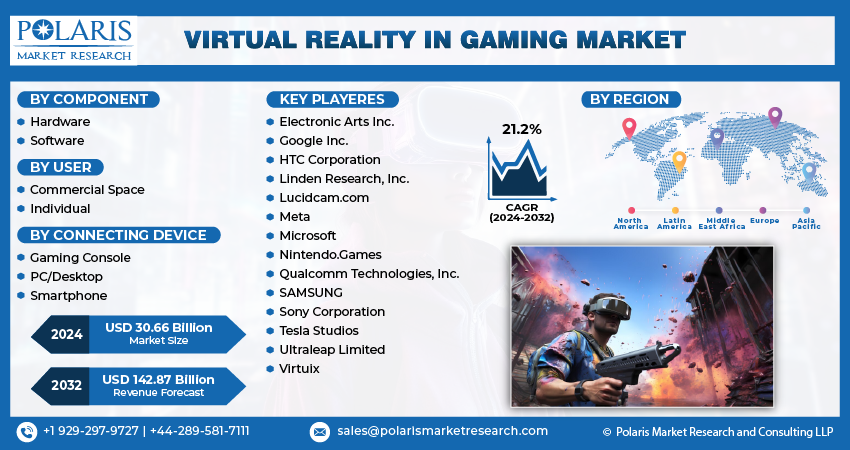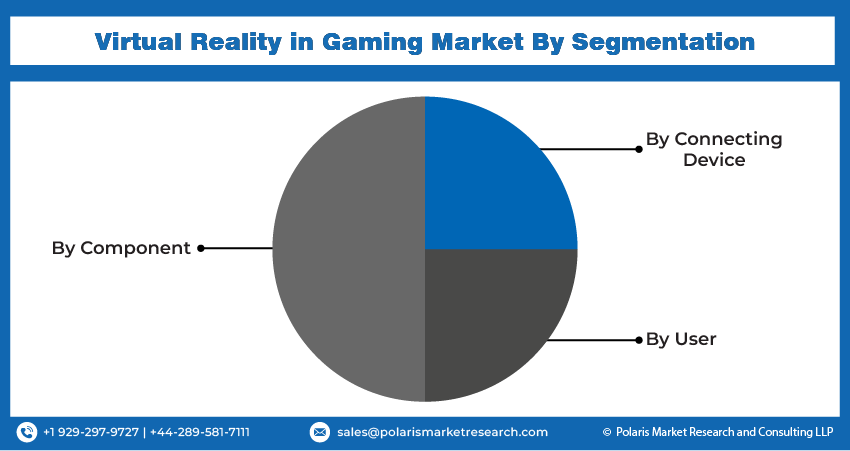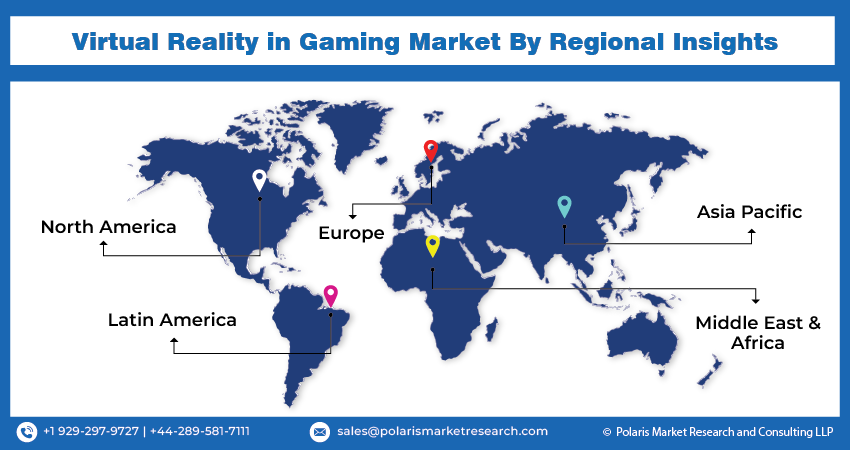
Global Virtual Reality (VR) In Gaming Market Share, Size, Trends, Industry Analysis Report
: Information By Component (Hardware, Software), By Connecting Device, By User, And By Region (North America, Europe, Asia-Pacific, Latin America, and Middle East Africa) – Market Forecast, 2024 - 2032
- Published Date:Jan-2024
- Pages: 117
- Format: PDF
- Report ID: PM1082
- Base Year: 2023
- Historical Data: 2019-2022
Report Outlook
Global Virtual Reality (VR) In Gaming Market Size was valued at USD 25.37 Billion in 2023. The Virtual Reality In Gaming Industry is projected to grow from USD 30.66 Billion in 2024 to USD 142.87 Billion by 2032, exhibiting a compound annual growth rate (CAGR) of 21.2% during the forecast period (2024 - 2032). Virtual Reality (VR) utilizes simulation and computer modeling to create a three-dimensional visual and sensory environment. The market is being driven by the widespread adoption of VR headsets and accessories, as well as the increasing demand for enhanced gaming experiences. VR has revolutionized gaming by providing real-time immersion for players and introducing innovative virtual accessories that intensify user engagement. Ongoing advancements in technologies such as motion tracking, 3D effects, and interactive graphics are captivating players and contributing to industry growth.

To Understand More About this Research: Request a Free Sample Report
Furthermore, investors and entrepreneurs have displayed significant interest in the virtual reality (VR) sector. Considerable investments in immersive technology within tech-based companies signal an emerging trend in the entertainment and computing industries. For instance, according to NASSCOM, content creation tools garnered 43.5% of the total funding for virtual reality (VR) in the specified period. This highlights the growing importance of ensuring superior content development to sustain interest, meet demand, and supply immersive experiences through virtual reality (VR).
Companies are consistently involved in research and development endeavors to introduce technologically advanced products, aiming to gain a competitive edge. In the virtual reality (VR) in gaming market, players are producing a range of accessories, including motion-sensing devices, treadmills, gloves, arms, and full bodysuits. The increasing demand for virtual reality (VR) accessories and wearables among users, coupled with potential price reductions in the next few years, is expected to propel the growth of the virtual reality (VR) gaming market. However, the challenge of device compatibility limitations acts as a barrier to the industry's growth.
Virtual Reality (VR) Market Trends:
Immersive Gaming Experience Is Driving The Market Growth
Market CAGR for virtual reality (VR) in gaming is being driven by more immersive and realistic gaming experiences by placing users directly in the virtual environment. This heightened level of immersion is a key driver as gamers seek more engaging and interactive experiences. The realm of virtual reality gaming is witnessing an increase in its professional significance through innovative advancements. There is a growing awareness among players about advanced VR accessories, including headsets, bodysuits, and gloves. The introduction of VR headsets marked a revolutionary moment in the entertainment industry. This led to a surge in demand for virtual reality games as users sought to experience 3D characters within their virtual environments. The VR devices utilized in the market are equipped with intelligent interactive hardware and software, enhancing the overall entertainment experience for users.
Growing User Base In The Video Game Industry Is Fueling The Market Growth
The growing user base in the video game industry is serving as a major driver for the expansion of virtual reality (VR) in gaming market. This trend is leading to an increased demand for immersive gaming experiences and a wider customer base. For instance, according to Newzoo International BV, the global number of video game players reached 2.69 billion in 2020 and increased to 3.22 billion in 2023. As the worldwide gaming community expands, there is an increasing demand for creative and captivating content to meet the needs of the growing audience. The popularity of VR-ready games and platforms is further bolstered by the rising interest for more realistic and captivating environments where players experience a heightened sense of presence and interactivity. This growing interest is encouraging game developers to create a diverse range of virtual reality (VR) titles. Consequently, the burgeoning population of gamers is a key driver propelling the expansion and evolution of the virtual reality (VR) gaming industry.
Growing Investment From Tech Companies And Gaming Studios Are Driving The VR in Gaming Market Growth
The increasing financial investment from tech companies and gaming studios is playing a pivotal role in fueling the virtual reality (VR) in gaming market growth. This is leading to expedited advancements and widespread acceptance of VR technologies. Tech giants and gaming studios are pouring substantial resources into research and development to enhance VR hardware and software, resulting in more advanced and user-friendly VR headsets, controllers, and immersive gaming environments. For instance, in February 2024, AutoVRse, a Bengaluru-based virtual reality (VR) and Augmented Reality (AR) company, secured a funding round of US$2 million, with Lumikai leading the investment. The company plans to utilize the funds to scale up its virtual reality (VR) enterprise training and gaming solutions. These investments lead to the creation of high-quality, engaging VR content that attracts gamers, thereby expanding the market. As a result, these growing investments are propelling the virtual reality (VR) in gaming Market toward sustained growth.

Virtual Reality (VR) in Gaming Market Segment Insights:
Virtual Reality (VR) in Gaming Component Insights:
The global virtual reality (VR) in gaming Market segmentation, based on component includes hardware and software. The hardware segment dominated the market in 2023 due to the essential role it plays in delivering the immersive experiences that define virtual reality (VR) in gaming. Virtual Reality (VR) hardware, including headsets, controllers, motion sensors, and haptic feedback devices, is critical for creating realistic and interactive environments that attract gamers. Continuous advancements in VR hardware technology, such as improved resolution, wider field of view, and more responsive tracking systems, enhance the overall user experience and make Virtual Reality (VR) gaming more appealing. For instance, in May 2024, Rain Technology announced its plan to launch advancements in Anamorphic-XR, the company's patented optical engine for Augmented Reality (AR) and virtual reality (VR) headsets. This optical engine is highly advanced and offers directional display technologies for augmented reality (AR) and virtual reality (VR) applications. As a result, the development and release of these virtual reality (VR) headsets contribute to the dominance of the hardware segment.
Virtual Reality (VR) in Gaming User Insights:
The global virtual reality (VR) in gaming market segmentation, based on user, includes commercial space and individual. The individual user segment is expected to grow significantly in virtual eality (VR) in gaming market due to the increasing accessibility and affordability. As virtual reality hardware becomes more affordable and user-friendly, more individual consumers are investing in personal virtual reality (VR) systems for home use. The growing library of virtual reality (VR) games and experiences, ranging from casual to highly immersive and interactive titles, caters to a wide array of interests and preferences, attracting a broader audience. Furthermore, advancements in virtual reality (VR) technology, such as improved graphics, better motion tracking, and standalone headsets, enhance the user experience and make VR gaming more attractive to individual users. For instance, in January 2024, Pimax, a company in the virtual reality (VR) industry, launched its 60G AirLink wireless module in combination with Pimax's flagship product, the Pimax Crystal. The incorporation of the 60G AirLink with Crystal's standard eye-tracking feature established it as a UHD (Ultra-High-Definition) virtual reality (VR) headset with seamless wireless connectivity. As a result of these technological improvements in VR headsets, the individual user segment is anticipated to grow substantially in the virtual reality (VR) in gaming market.
Global Virtual Reality in Gaming Market, Segmental Coverage, 2019 - 2032 (USD Billion)

Source: Secondary Research, Primary Research, PMR Database and Analyst Review
Virtual Reality (VR) in Gaming Regional Insights:
By region, the study provides the VR in gaming market insights into North America, Europe, Asia-Pacific, Latin America, and Middle East & Africa. North American virtual reality (VR) gaming market witnessed dominance in the global market outlook due to its advanced technological infrastructure, strong presence of major tech companies and game developers, and high consumer adoption rates. Further, the region dominance is due to the presence of several industry giants, such as Oculus (Meta), Google, and Microsoft, which are at the forefront of VR innovation and development.
Furthermore, the U.S. virtual reality (VR) in gaming market is experiencing rapid growth, driven by a strong gaming culture and significant investment from leading tech companies. The U.S. is at the forefront of VR advancements, continually pushing the boundaries with cutting-edge hardware and immersive gaming experiences. The high consumer demand for new and engaging gaming formats fuels the market, supported by the country's technophile population.
Further, the major countries studied in the market report are The US, Canada, German, France, the UK, Italy, Spain, China, Japan, India, Australia, South Korea, and Brazil.
Global Virtual Reality (VR) in Gaming Market Share, Regional Coverage, 2019 - 2032 (USD Billion)

Source: Secondary Research, Primary Research, PMR Database and Analyst Review
Asia Pacific virtual reality (VR) in gaming market is expected to grow at a substantial CAGR over the market forecast period due to the region's expanding base of avid gamers, which creates significant demand for immersive and cutting-edge gaming experiences. The growing cultural interest in gaming, as seen in the rise of esports and gaming cafes, is playing a significant role in driving the widespread acceptance of virtual reality (VR) technology.
Moreover, China and Japan play a pivotal role in the growth of Asia Pacific region, contributing to a higher market share. The significant consumer base in China, coupled with the widespread adoption of VR games on smartphones, has fueled the expansion of the market. Also, the deployment of high-speed 5G networks has enhanced the overall gaming experience. These advancements, combined with the increasing number of gamers, are driving the Asia Pacific virtual reality (VR) in gaming market.
Virtual Reality (VR) in Gaming Key Market Players & Competitive Insights
Leading market players are investing heavily in research and development in order to expand their product lines, which will help the virtual reality (VR) in gaming market, grow even more. Market participants are also undertaking a variety of strategic activities to expand their global footprint, with important market developments including new product launches, contractual agreements, mergers and acquisitions, higher investments, and collaboration with other organizations. To expand and survive in a more competitive and rising market climate, virtual reality (VR) in gaming industry must offer cost-effective items.
Manufacturing locally to minimize operational costs is one of the key business tactics used by manufacturers in the global virtual reality (VR) in gaming industry to benefit clients and increase the market sector. In recent years, the virtual reality (VR) in gaming industry has offered some technological advancements. Major players in the virtual reality (VR) in gaming market, including Electronic Arts Inc., Google, HTC Corporation, Linden Research, Inc., Meta, Microsoft, Nintendo, Qualcomm Technologies, Inc., Samsung, Sony Interactive Entertainment LLC, Virtuix.
Sony Group Corporation is a multinational corporation that specializes in the design, production, development, and sale of electronic equipment across various markets. The company operates in Japan, Europe, the United States, China, and globally. Sony is involved in the distribution of software titles and add-on content through digital networks, as well as the provision of network services for video, game, and music content. Sony also offers home gaming consoles, packaged and game software, and peripheral devices. In December 2023, Sony introduced the PlayStation VR2, its second-generation virtual-reality headset, in the Indian market. This advanced headset is equipped with two OLED displays, providing stunning 4K HDR visuals at a remarkable refresh rate of up to 120 frames per second.
Meta creates products that facilitate social connectivity and sharing through various technological platforms, such as personal computers, mobile devices, wearables, and virtual reality headsets, on a global scale. The company operates within two main segments: Family of Apps and Reality Labs. In April 2021, Capcom partnered with Armature Studio and Oculus Studios (Meta) to bring its game Resident Evil 4 to VR, only for the Oculus Quest 2.
Key Companies in the Virtual Reality (VR) in Gaming Market include:
- Electronic Arts Inc.
- HTC Corporation
- Linden Research, Inc.
- Meta
- Microsoft
- Nintendo
- Qualcomm Technologies, Inc.
- Samsung
- Sony Interactive Entertainment LLC
- Virtuix
Virtual Reality (VR) in Gaming Industry Developments
June 2023: Meta Platforms (META) announced a VR gaming subscription service. The new initiative allows subscribers to retain access to games as long as they remain active members of Meta Quest+.
November 2022: Meta introduced the XTADIUM app for Meta Quest, which delivers an immersive 180-degree VR experience of sports events. The app features real-time statistical overlays and provides users with up to eight different camera angles to select from.
October 2022: Microsoft announced a partnership with Meta to introduce a virtual reality (VR) experience. This partnership was focused on integrating Microsoft's suite of productive tools into VR headsets, aligning with Meta's overarching Metaverse initiative.
Virtual Reality (VR) in Gaming Market Segmentation:
Virtual Reality (VR) in Gaming Component Outlook
- Hardware
- Software
Virtual Reality (VR) in Gaming Connecting Device Outlook
- Gaming Console
- PC/Desktop
- Smartphone
Virtual Reality (VR) in Gaming, User Outlook
- Commercial Space
- Individual
Virtual Reality (VR) in Gaming Regional Outlook
- North America
- US
- Canada
- Europe
- Germany
- France
- UK
- Italy
- Spain
- Netherlands
- Russia
- Rest of Europe
- Asia-Pacific
- China
- Japan
- India
- Malaysia
- South Korea
- Indonesia
- Australia
- Rest of Asia-Pacific
- Middle East & Africa
- Saudi Arabia
- UAE
- Israel
- South Africa
- Rest of Middle East & Africa
- Latin America
- Mexico
- Brazil
- Argentina
- Rest of Latin America
Virtual Reality (VR) in Gaming Report Scope:
|
Report Attributes |
Details |
|
Market size value in 2023 |
USD 25.37 Billion |
|
Market size value in 2024 |
USD 30.66 Billion |
|
Revenue Forecast in 2032 |
USD 142.87 Billion |
|
CAGR |
21.2% from 2024 – 2032 |
|
Base year |
2023 |
|
Historical data |
2019 – 2022 |
|
Forecast period |
2024 – 2032 |
|
Quantitative units |
Revenue in USD Billion and CAGR from 2024 to 2032 |
|
Report Coverage |
Revenue Forecast, Market Competitive Landscape, Growth Factors, and Trends |
|
Segments covered |
|
|
Regional scope |
|
|
Competitive Landscape |
|
|
Report Format |
|
|
Customization |
Report customization as per your requirements with respect to countries, region and segmentation. |
FAQ's
The global VR in gaming market size was valued at USD 25.37 Billion in 2023 and projected to be valued at USD 30.66 Billion by 2032
The global market is projected to grow at a CAGR of 21.2% during the forecast period, 2024-2032.
North America had the largest share in the global market
The key players in the market are Electronic Arts Inc., Google, HTC Corporation, Linden Research, Inc., Meta, Microsoft, Nintendo, Qualcomm Technologies, Inc., Samsung, Sony Interactive Entertainment LLC, Virtuix.
The hardware category held the highest share in the market in 2023
The individual user had the highest CAGR in the global market
